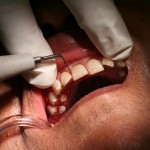
Patients attending for their regular dental check up (usually 6-monthly) are likely to have a ‘scale and polish (oral prophylaxis) as part of that visit. However, a Cochrane review last updated in 2007 did not find evidence of sufficient quality to reach conclusions as to the benefits or harms or routine scaling and polishing. A more recent trial published by Jones et in 2011 also found no differences for single-visit scale and polish provided at 6, 12 and 24 month frequencies for healthy patients. This current study reports the patient perceptions from that trial.
Regular Adult dental patients (18-60 yrs) with no systemic risk factors for periodontal disease and no clinical evidence of significant periodontal disease were recruited. All participants received a single-visit scale and polish at baseline. One group represented the traditional routine 6- monthly regime (6-month group) and received single-visit scale and polish at each recall appointment (6-, 12-, and 18-months.) A second group (12-month group) received scale and polish at the 12-month recall appointment only. The third group (24-month group) did not receive a scale and polish after baseline
Measurements were taken at baseline and 24-month follow-up. Oral cleanliness was reported using a 5-point scale and recorded by examiners blinded to trial group allocation. A self-completed questionnaire enabled participants to report perceived importance of scale and polish (5-point scale), and required frequency of treatment (6-point scale). The main hypothesis was that participants receiving 6-monthly scale and polish would report higher levels of oral cleanliness compared to participants receiving scale and polish at 12- and 24-month intervals.
- 369 patients were randomised: 125 to the 6-month group; 122 to the 12-month group; and 122 to the 24-month group.
- 308 (83.5%) of those recruited attended both baseline and follow-up appointments
- Patients in the 24-month group were significantly less likely (P = 0.003) to report a ‘high’ level of oral cleanliness (30%, OR 0.40; 95% CI 0.22, 0.74) compared to the 6-month group (52.3%). There was no significant difference between the 12- month group (47%, OR 0.95; 95% CI 0.53, 1.70) and the 6-month group.
- Patient reported scores for the importance of scale and polish with respect to oral health (clean mouth, healthy gums, fresh breath, white teeth, prevention of caries) were not significantly different between groups at follow-up.
- The majority of patients at follow-up (77.9%, 71.7% and 64.9% in the 6-month, 12- month and 24-month groups respectively) reported that they required a scale and polish every 6 months or more frequently.
The authors concluded
The majority of healthy adults regarded 6-monthly single-visit scale and polish as being beneficial for their oral health. Receiving the treatment at different frequencies did not alter this belief; and those with the longest interval between scale and polish provision perceived that their mouth was less clean. In the absence of a strong evidence base to support (or refute) the effectiveness of single-visit scale and polish, the beliefs and preferences of patients regarding scale and polish may be influential drivers for maintaining provision of this treatment.
Comment
Scale and polish has been a routine element of a dental check up for a significant number of patients over many years so it is perhaps not surprising for patients to come to associate this treatment as being beneficial for their oral health. The authors suggest that should higher quality evidence become available in the future that were to demonstrate a lack of benefit it may prove a challenge to withdraw this treatment owing to the views and beliefs of dentists and their patients. This may be an issue and further work to better understand patients belives in relation scale and polish would be helpful in addition to higher quality studies to identify teh benefits and/or harms of routine scale and polish for essentially healthy patients.
Links
Jones C, Macfarlane TV, Milsom KM, Ratcliffe P, Wyllie A, Tickle M. Patient perceptions regarding benefits of single visit scale and polish: a randomised controlled trial. BMC Oral Health. 2013 Oct 3;13(1):50. [Epub ahead of print] PubMed PMID: 24090395.
Jones CL, Milsom KM, Ratcliffe P, Wyllie A, Macfarlane TV, Tickle M. Clinical outcomes of single-visit oral prophylaxis: a practice-based randomised controlled trial. BMC Oral Health. 2011 Dec 28;11:35. doi: 10.1186/1472-6831-11-35. PubMed PMID: 22204658; PubMed Central PMCID: PMC3280181.
Beirne PV, Worthington HV, Clarkson JE. Routine scale and polish for periodontal health in adults. Cochrane Database of Systematic Reviews 2007, Issue 4. Art. No.: CD004625. DOI: 10.1002/14651858.CD004625.pub3.

V interesting findings!No more SnPs on Band1 NHS then as no real clinical benefit! #controversial?
@thedentalelf http://t.co/xx8achmDiB